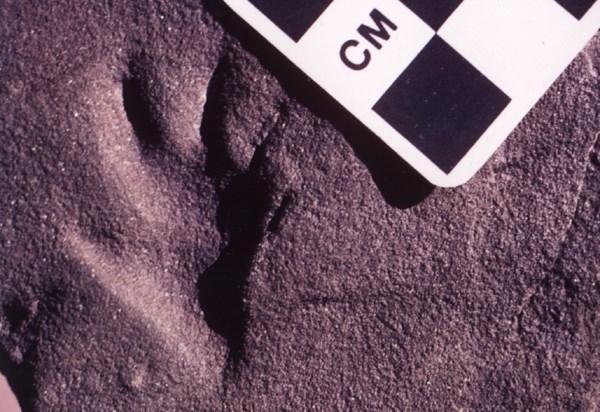Part of a series of articles titled Geologic Time Periods in the Mesozoic Era.
Previous: Jurassic Period—201.3 to 145.0 MYA
Article

NPS image
In 1834 Fredrich von Alberti, a longtime official in the German salt-mining industry, introduced “Triassic” as a descriptive term for a sequence of rocks within a striking threefold division: red beds, topped by chalk, followed by black shale. The term is thus essentially descriptive. In the type area of southern Germany, the strata are widely traceable but poorly fossiliferous. In the Alps to the south, however, a complete sequence of marine faunas provides the standard of reference for worldwide correlation today (Eicher 1976).
The Mesozoic Era begins with the Triassic Period. This era is popularly known as the “Age of Reptiles” and for good reason: reptiles, and particularly dinosaurs, were the dominant land-dwelling vertebrate animals at the time. During the Triassic, the first dinosaurs walked on the land, the first pterosaurs sailed through the skies, and the first ichthyosaurs and plesiosaurs swam in the oceans. The lineage of many modern-day reptiles began in the Triassic Period, including crocodiles, lizards, and turtles. Other now-extinct reptiles first appeared during the Triassic: the fish-like ichthyosaurs and plesiosaurs with their long limbs and necks and small heads. On the tectonic side of things, Pangaea began to break apart, a process that continued into the Cenozoic Era. The Triassic ended with the world’s fourth, but not last, mass extinction.
Every park contains some slice of geologic time. Here we highlight a few parks associated with the Triassic Period. This is not to say that a particular park has only rocks from the specified period. Rather, rocks in selected parks exemplify a certain event or preserve fossils or rocks from a certain geologic age.
Arches National Park (ARCH), Utah—[ARCH Geodiversity Atlas] [ARCH Park Home] [ARCH npshistory.com]
Canyon de Chelly National Monument (CACH), Arizona—[CAHA Geodiversity Atlas] [CACH Park Home] [CACH npshistory.com]
Canyonlands National Park (CANY), Utah—[CANY Geodiversity Atlas] [CANY Park Home] [CANY npshistory.com]
Capitol Reef National Park (CARE), Utah—[CARE Geodiversity Atlas] [CARE Park Home] [CARE npshistory.com]
Colorado National Monument (COLM), Colorado—[COLM Geodiversity Atlas] [COLM Park Home] [COLM npshistory.com]
Dinosaur National Monument (DINO), Colorado & Utah—[DINO Geodiversity Atlas] [DINO Park Home] [DINO npshistory.com]
Glen Canyon National Recreation Area (GLCA), Arizona & Utah—[GLCA Geodiversity Atlas] [GLCA Park Home] [GLCA npshistory.com]
Petrified Forest National Park (PEFO), Arizona—[PEFO Geodiversity Atlas] [PEFO Park Home] [PEFO npshistory.com]
Wrangell - St. Elias National Park and Preserve (WRST), Alaska—[WRST Geodiversity Atlas] [WRST Park Home] [WRST npshistory.com]
Wupatki National Monument (WUPA), Arizona—[WUPA Geodiversity Atlas] [WUPA Park Home] [WUPA npshistory.com]
Zion National Park (ZION), Utah—[ZION Geodiversity Atlas] [ZION Park Home] [ZION npshistory.com]
Part of a series of articles titled Geologic Time Periods in the Mesozoic Era.
Previous: Jurassic Period—201.3 to 145.0 MYA
Last updated: April 28, 2023